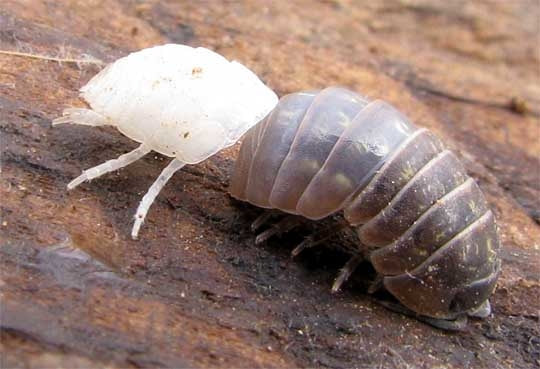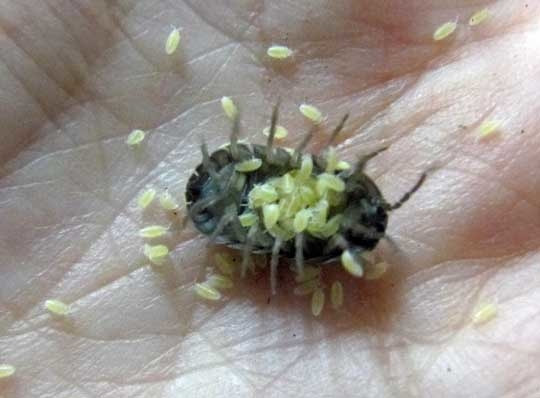|
This week's Awesome Animal is one that plays an important role in my upcoming novel, Bridgers 4! The animal is the PILLBUG. Well, it isn't really pillbugs that show up in the book. It's actually... well, you're just going to have to read the book when it comes out in late November. You see, pillbugs are near and dear to my heart. Why? Well, back when I was teaching biology to 7th graders (kids 12 to 13 years old), I did a major research and creative-writing project that involved pillbugs. More on that below. But other than that, pillbugs are just awesome! I may need to explain that the name, Pillbug, may not be known to everyone everywhere. Around here, many people call them roly polies. They are also called woodlice, isopods, armadillo bugs, potato bugs, doodle bugs, and my favorite, chuggypigs. I would be interested to know what people call them where you live... please reply and let me know. So, what the heck is a Pillbug? A pillbug is not really a bug. It's not an insect. It's actually a crustacean. You know what crustaceans are, right? Crustaceans include lobsters, crabs, shrimp, crayfish, krill, barnacles, and many others. Pillbugs are unusual for crustaceans in that they are terrestrial (they live on land instead of in water). Pillbugs are in an order of crustaceans called isopods. This also includes sowbugs, which are similar to pillbugs. But pillbugs have a superpower that sowbugs don't--the ability to roll into a ball, which is how they got the name pillbug. Amazing facts about Pillbugs As mentioned above, pillbugs have the ability to roll into a tight ball. There is actually a name for this. To roll into a ball is to conglobate. The obvious benefit of conglobation is protection from predators. But some biologists believe it is even more important as a way to avoid dehydration. Pillbugs are about the only crustaceans that live on land, and they are not as well adapted to dry land as insects. They do not have the waterproof waxy coating that insects have. They use gill-like structures to breath, and therefore they have to spend their time in moist areas under rocks and logs, and if you put them in a dry environment, they will roll into a ball to keep from drying out. Here is a conglobating pillbug: Pillbugs can drink through their anus. Actually, they can and do suck up water through their mouth parts, like we do. But remember, they are very sensitive to drying out, so they also have the ability to take in water through special tubes at their rear end, called uropods. Okay, weird. Pillbugs do not pee. That's right. They do not need to urinate. Most animals cannot tolerate ammonia, which happens to be present in the wastes that are created inside our bodies. Most animals convert these wastes into urea and then squirt that out of their bodies. That's urine. But pillbugs have an amazing tolerance for ammonia gas, and they can just excrete it directly out through their exoskeleton. Wow, it would be nice to not have to pee. I could sleep through the whole night! Pillbugs molt in two sections. As crustaceans, pillbugs are included in the larger group, Arthropods (which also includes insects, spiders, and more). Arthropods have exoskeletons, and almost all of them grow larger by periodically molting their exoskeleton (which doesn't grow once it hardens). Beneath the shed exoskeleton is a new, soft exoskeleton, which immediately grows larger before it hardens up. Pillbugs are different in that they first shed the exoskeleton on their back half. Then a few days later they shed the front half. Check out this cool video of pillbugs molting. Pillbugs walk around on seven pairs of legs. Strangely, though, when baby pillbugs hatch, they only have six pairs of legs. They don't get the seventh pair until after they molt for the first time. Pillbugs eat decaying matter on the forest floor and under rocks and logs. They also eat their own poop. That's right. It's a real thing among may animals, and it is called coprophagy. Other animals do it for different reasons, but pillbugs do it to conserve copper. Pillbugs need copper in their bodies, and they lose some of it every time they poop. So they have a habit of eating their poop to conserve the copper. Female pillbugs carry their babies around on their underneath side. The eggs are layed and then transferred to the marsupium (similar in function to a marsupial's pouch). The eggs hatch in the marsupium, and then the young hang on to the mother's underside for eight to twelve weeks as they develop. Okay, so I have to talk a bit about the The Pillbug Project (the actual title of a project I did with my 7th graders back in my teaching days). We formed a partnership with a dozen or so other schools in North America. The students in each partner class went out and collected pillbugs in their area. We then carried out a series of experiments with the pillbugs to see how well adapted they were to the climate in their area of the continent. These were simple choice experiments. For example, put the pillbugs in a container that is dry on one side and moist on the other side. After a specific amount of time, count how many are on each side. We did the same thing with warm and cool sides, light and dark sides, etc. Not surprisingly, we found that the ones from warm, dry areas of the continent were more comfortable on the dry side and on the warm side. Those from cooler, wetter regions were more comfortable on the cool side and wet side. And so on. There were many more experiments involved, but you get the idea. We also worked collaboratively with the students at the other schools to write a fun book about an intelligent pillbug from the future that travels back in time to teach a pair of teens about the history of life on Earth. This pillbug, named Armadillia, had a nifty little time machine attached to a belt around his waist. Below is a drawing one of my students created, his vision of what this fictional character should look like. So, the Pillbug deserves a place in the F.A.H.O.F. (Fetch Animal Hall of Fame). FUN FACT: The word fetch in this usage is, I suppose, a reduction of fetching, which means "attractive." Okay, I must admit, using the word fetch in this context isn't really a thing. It comes from the 2004 movie, Mean Girls, in which Gretchen tries to make fetch a thing but gets shut down by her friend, Regina George. Here's the clip. In spite of Gretchen's efforts, in the 14 years since the movie came out, fetch still isn't catching on. But Regina's response ("Stop trying to make Fetch happen!)" has now become a way to mock people who are out of touch. So... for Gretchen's sake, I'm going to say that fetch is another way to say awesome! Photo Credits:
Pillbug #1 - on finger - Backyard Nature Pillbug rolled up - James Castner, University of Florida. Pillbug Shedding - Backyard Nature Pillbug Babies - The Living Classroom
0 Comments
Leave a Reply. |
Stan's Cogitations
Everyone needs a creative outlet. That's why I write. Archives
July 2024
|







 RSS Feed
RSS Feed